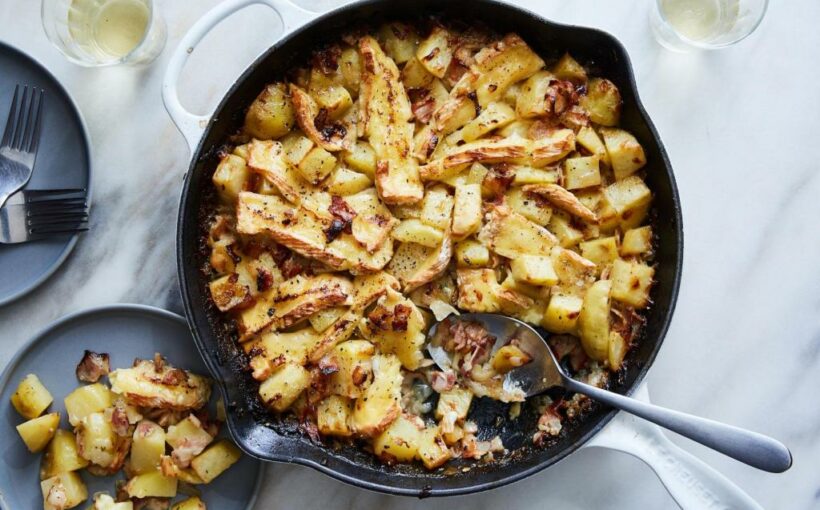By Melissa Clark, The New York Times
One of our many plans dashed because of the pandemic was a long-anticipated family vacation to the Alps.
We had it perfectly arranged: a weeklong extravaganza of vigorous hiking by day, offset by butter-filled feasting at night (and as many spa visits as I could fit in between).
When we canceled the trip, I vowed to fill my at-home vacation with as much Brooklyn “hiking,” bathtub spa-ing and Alpine-style feasting as was humanly possible.
And that was when I fell in love with tartiflette.
A glistening, golden-topped casserole from the French side of the Alps, tartiflette is traditionally filled with velvety potatoes and bits of brawny pork lardon, seasoned with sweet onions and cream. As a crowning touch, a small wheel of Reblochon cheese is tucked in among all that richness, so its insides can melt into a gooey puddle while the rind that pokes out on top crisps at its edges.
It’s not light fare, but it’s not supposed to be. Meant to fortify the body after a day of downhill skiing and other strenuous outdoor endeavors, it got me through many an icy walk in the wilds of Prospect Park.
The first time I made tartiflette, I followed a fairly traditional recipe, with one exception. Reblochon, the soft, creamy washed-rind cow cheese, is hard to track down in the United States. I substituted Camembert, which turned out beautifully; any creamy cheese with a bloomy, edible rind should work equally well.
I tweaked the technique for my next round of testing, streamlining the entire process from three separate pans to one 10- to 12-inch ovenproof skillet with a tightfitting cover. If you don’t have a large enough skillet, a 5- or 6-quart Dutch oven will also work. Just note that because of the greater depth, the cheese may not become quite as bronzed. It’s a small quibble but one worth mentioning in case you were counting on those crackling bits of brown butterfat speckling the surface.
I like to serve tartiflette with a tangy salad of winter greens to cut the richness. Some bracing mix of radicchio, endive, escarole, watercress or arugula is ideal, maybe with a sliced ripe pear thrown in for a touch of sweetness.
Accompanied by a bottle of good wine, a plateful of tartiflette did, temporarily, fill the void of a lost vacation, and gave me something to look forward to when I can travel again.
RECIPE: Tartiflette
Yield: 6 servings
Total time: 1 hour, 20 minutes
Ingredients
- 8 ounces thick-cut bacon, diced
- 2 medium yellow onions, diced (about 2 1/2 cups)
- 2 garlic cloves, finely grated or minced
- 1 teaspoon finely chopped fresh thyme leaves
- Pinch of freshly grated nutmeg
- 2 pounds Yukon gold or other waxy potatoes, peeled and cut into 1-inch cubes (about 5 1/2 cups)
- 3/4 cup dry white wine
- Kosher salt and black pepper
- 8 to 10 ounces soft cow’s milk cheese with a bloomy rind, such as Reblochon, Camembert or Brie
- 1/2 cup crème fraîche
Preparation
1. Heat oven to 400 degrees. Add bacon to a cold (10- to 12-inch) skillet and place the pan over medium heat. Let bacon cook until some of the fat renders and the edges turn golden, about 7 to 10 minutes. (You’re not looking to crisp the bacon.)
2. Add onions to the pan and raise the heat to medium-high. Cook, stirring occasionally, until golden and soft, about 10 minutes longer. Stir in garlic, thyme and nutmeg, and cook for another minute until fragrant.
3. Add potatoes, wine, 1/2 teaspoon salt and 1/2 teaspoon pepper, and toss until well combined. Cover the pan and cook, stirring every once in a while so nothing sticks, until potatoes are just tender and the liquid has mostly evaporated, 20 to 25 minutes. If the pan dries out while the potatoes are cooking, add a splash or two of water.
4. Leaving the rind on, cut the cheese into slices or wedges. Stir crème fraîche into the potatoes, then nestle the cheese in evenly. Transfer the skillet to the oven and bake, uncovered, until the cheese melts and the potatoes are very tender, 25 to 35 minutes. Serve hot or warm.
And to Drink …
This hearty, Alpine dish, perfect for après-ski or any cold night near a fireplace, hails from the Savoie region of eastern France, right on the border of Switzerland. Any cold, crisp white from either of those regions, made from grapes like gringet, altesse and chasselas, would be lovely. These wines are not so easy to find, but alternatives will be just as good. An aligoté from Burgundy would be wonderful, as would a savagnin or chardonnay from the Jura, Savoie’s neighbor to the north. You could try a Muscadet or one of the constellation of sauvignon blanc wines from the Loire Valley. If you prefer a red, look for something light, fruity and energetic. A Jura poulsard or trousseau would be just right, as would a Loire gamay.
— Eric Asimov
Source: Read Full Article
